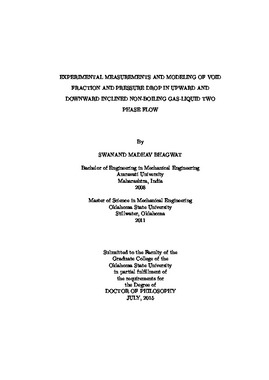| dc.contributor.advisor | Ghajar, Afshin | |
| dc.contributor.author | Bhagwat, Swanand Madhav | |
| dc.date.accessioned | 2016-09-29T18:38:22Z | |
| dc.date.available | 2016-09-29T18:38:22Z | |
| dc.date.issued | 2015-07 | |
| dc.identifier.uri | https://hdl.handle.net/11244/45233 | |
| dc.description.abstract | The prime objective of this research is to contribute to the fundamental understanding of the effect of upward and downward pipe inclinations on flow patterns, void fraction and pressure drop in non-boiling gas-liquid two phase flow. To accomplish the proposed objective, 2970 experimental measurements are carried out using air-water fluid combination in a 0.5" I.D. polycarbonate (smooth) and stainless steel (rough) pipes mounted on a variable inclination frame. Based on flow visualization, flow pattern maps are developed for each pipe orientation and a significant effect of change in pipe orientation is found on the transition between stratified-slug and stratified-intermittent flow patterns. The physical structure as well as the transition between intermittent-annular flow patterns is found to be virtually independent of the pipe orientation. Based on this flow visualization data and that collected from literature, an empirical model is developed to predict occurrence of stratified flow in horizontal and downward inclined pipes. Experimental measurements show that the effect of change in pipe orientation on the void fraction as well as two phase pressure drop is significant at low liquid and gas flow rates. This effect is essentially due to the change in flow pattern and the relative dominance between buoyancy and inertia forces. It is observed that the increase in pipe surface roughness increases the frictional pressure drop with increase in gas and liquid flow rates. Effect of pipe roughness on the frictional pressure drop is found to be independent of the pipe orientation. A comprehensive data bank is generated using the experimental data collected in this study and that available in the open literature and is used to develop flow pattern independent models to predict void fraction and frictional pressure drop. Void fraction correlation applicable for micro to macro scale two phase flow is developed based on drift flux modeling technique. Frictional pressure drop correlation also applicable for micro macro scale two phase flow is based on separated flow model and provides an expression to predict two phase frictional multiplier as a function of several two phase flow variables. Both of these correlations are valid for non-stratified two phase flows. | |
| dc.format | application/pdf | |
| dc.language | en_US | |
| dc.rights | Copyright is held by the author who has granted the Oklahoma State University Library the non-exclusive right to share this material in its institutional repository. Contact Digital Library Services at lib-dls@okstate.edu or 405-744-9161 for the permission policy on the use, reproduction or distribution of this material. | |
| dc.title | Experimental measurements and modeling of void fraction and pressure drop in upward and downward inclined non-boiling gas-liquid two phase flow | |
| dc.contributor.committeeMember | Sallam, Khaled | |
| dc.contributor.committeeMember | Cremaschi, Lorenzo | |
| dc.contributor.committeeMember | Aichele, Clint | |
| osu.filename | Bhagwat_okstate_0664D_14155.pdf | |
| osu.accesstype | Open Access | |
| dc.type.genre | Dissertation | |
| dc.type.material | Text | |
| thesis.degree.discipline | Mechanical and Aerospace Engineering | |
| thesis.degree.grantor | Oklahoma State University | |
